Meet the leadership team of USC CAIS
Technology proves every day it can transform lives. Can it also transform problems like homelessness, substance abuse and the spread of sexually transmitted infections?
That’s the hope of the four leaders of the USC Center for Artificial Intelligence in Society (CAIS).
At a recent seminar, USC CAIS co-founder and director Eric Rice joined the Centers’ three associate directors for a wide-ranging discussion about the collaborative venture between the USC Suzanne Dworak-Peck School of Social Work and the USC Viterbi School of Engineering. Its aim? To tackle societal problems using artificial intelligence (AI).
True Collaboration
Unraveling big, thorny problems like homelessness, HIV prevention and more requires new ways of thinking about these issues, Rice said. Part of the challenge, in Rice’s view, is that we’ve become too siloed in how we approach solutions. Social workers do things according to the history and traditions of their discipline; computer scientists have their own ways. A truly multidisciplinary approach means meeting in the middle.
In creating USC CAIS in 2016, Rice’s thinking was to generate a space where computer and social work scientists worked together as equal partners.
“If we were going to pursue AI for social good, we wanted it to be more than just computer scientists working with community organizations or social work researchers using out-of-the-box machine learning tools,” Rice said. “If we bring [researchers] together in a more meaningful way, we might come up with something new.”
This equal partnership is what sets USC CAIS apart from other research centers, Rice said. It also may be key to unlocking solutions to these wicked problems.
Real World Results
The promise of artificial intelligence to improve society is what drew Phebe Vayanos, USC CAIS associate director and assistant professor in the Daniel J. Epstein Department of Industrial & Systems Engineering and Computer Science at USC Viterbi School of Engineering, to work with Rice and USC CAIS. Previously working in finance, Vayanos had to solve challenging risk management and portfolio optimization problems, which was very rewarding from a technical/mathematical perspective. Yet, she was looking for more: something rewarding on a personal level too. She found that at USC CAIS.
Today, she’s working on projects in collaboration with Rice that aim to help with housing allocation for those experiencing homelessness as well as work on suicide prevention.
“From an engineering perspective, I feel that taking your research all the way from the lab to the field is something that not many research groups do,” Vayanos said. Other researchers may be developing algorithms and methodologies with real data, but what sets USC CAIS apart is that they also see the hard work pay off in the real world.
Machine Learning to Predict Drug Use Relapse
For social workers, social science practitioners, and policymakers, making sense of big data to predict behaviors can be critical in deploying solutions while working within tight resource constraints. In other words, computer science algorithms can help us use the same level of resources but in more effective ways.
Using these new tools to help organizations solve their problems is what excites Jordan Davis, USC CAIS associate director and assistant professor at the USC Suzanne Dworak-Peck School of Social Work.
A project he just completed uses machine learning to help find the best predictors across male and female patients in treatment for opiate use disorder. His research narrowed in on how much time passes before the patient relapses, or latency to use. The models may help predict when treatment specialists schedule “booster sessions.”
By understanding which patients have a greater probability of relapse, treatment centers can use what Davis calls a “dentist’s check-up model” to bring them back in at regular intervals. “The idea is that we’re not just brushing our hands and saying good luck to them,” he said. Booster sessions at just the right time may help. Davis is spearheading the collaborative team on a few new substance abuse prevention and treatment projects, which will hopefully be funded within the coming year.
Big Problems, Innovative Solutions
Bistra Dilkina, USC CAIS associate director and assistant professor in Computer Science at the USC Viterbi School of Engineering, is very passionate about using AI for biodiversity conservation and disaster planning.
“Extinction rates are rising, mostly because of urbanization [and] deforestation,” Dilkina said. Helping agencies protect biodiversity using data-driven decision-making is important to her.
She has several projects using algorithms to help make decisions about conservation reserves and wildlife corridors, along with planning and optimization algorithms to help communities to be prepared for natural disasters.
“For me, a driving force has been using AI in ways that can inform solving some wicked social and environmental sustainability problems,” Dilkina said. “These are areas in which we have very limited resources, very complex dynamics, and very challenging problems.”
Rice and the team hope that those challenges and the potential impact will draw more faculty and students to get involved.
“We think of these social or environmental problems as so vexing. But if we start to think about formalizing them as math problems that computer scientists can tackle, then I think the sky is the limit about where this research can go,” Rice said.




